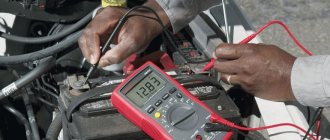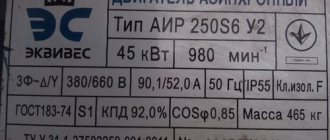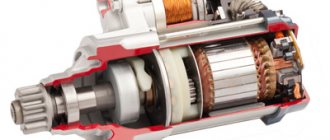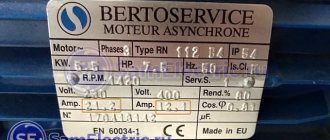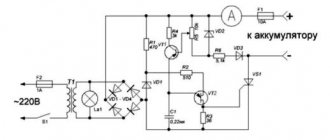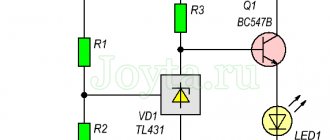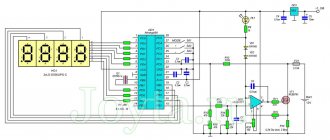When it comes to the most important characteristics of a car battery, most motorists mention battery capacity. Along with cost, in most cases it determines the choice when purchasing a new device. Meanwhile, the starting current of a car battery is no less important than the capacity, battery life or its dimensions.
Battery inrush current - what does it mean?
The starting system of each car consists of a battery, electrical wiring, ignition switch and starter. When you turn the key in the ignition switch, the power wires are connected, voltage is supplied to the relay, after which it goes to the starter. The starter turns the crankshaft and the car starts.
To operate the starter, a rechargeable battery is required, and since this element is a standard electric motor, it will require electric current to create an electromagnetic field in the stator (the stationary part).
When cranking a cold engine, greater effort is required, which means more current. The concept of the current that is necessary for high-quality cranking of the starter and subsequent starting of the engine is called starting current.
What is the starting current of a car battery can be understood from a simple formula: P=UI, where P is power, U is battery voltage (standard voltage is 12 V) and I is electric current. The relationship is simple: if the voltage remains constant, then with increasing power the electrical current should increase, in this case the starting current.
Methods for determining the battery release current
On an electric battery, the starting current is indicated by numbers, usually three digits. The numbers are followed by the letter A (Ampere). The starting current of the battery is measured in amperes.
Example of battery starting current designation:
- 500 A
- 600 A
- 680 A
- 900 A
In practice, there are several methods for determining the size of the starting current of a battery. Below are the main ones.
- SAE (Society of Automotive Engineers International) - Association of Automotive Engineers;
- IEC (IEC) International Electrotechnical Commission (World Electrotechnical Council)
- EN - European norms - European Committee for Standardization (CEN) European Council for Unification;
- DIN (Deutsches Institut fur Normung ev) German Higher School of Unification;
- JIS (Japanese Industrial Standards Committee) Japanese Standards Society;
- Standard R 53165-2008 is based on the worldwide template IEC 60095-1.
What determines the starting current of a battery?
We understand the concept of battery starting current and what it means. The main parameters of the battery that affect the magnitude of the starting current: the size of the lead plates and the area of each of them.
Modern battery models can be the same in capacity and size, but have a different starting current.
What does this depend on? From the manufacturer. For example, a Chinese battery in this parameter is inferior to a European power source by at least 30%. But the price of the latter is higher.
Causes of low capacity and insufficient starting current:
- The use of alloys with low-quality additives, instead of purified lead. The production price of such batteries is lower, but the quality remains at the same level.
- Fewer lead plates. For example, if a European manufacturer fits 5 plates into one battery jar, then a Chinese manufacturer can fit only 4. With a smaller number of plates, a larger charging current will be required to restore the capacity of such a battery, and this will reduce the number of charge/discharge cycles.
- Insufficient sealing of the housing. The battery design is based on good sealing, since during operation the car can produce too much charging current, which will lead to boiling of the electrolyte and its loss even through minor cracks.
- Larger internal volume. This is achieved by reducing the thickness of the housing walls. As the internal volume increases, the amount of electrolyte required for proper battery operation increases.
The only way to avoid getting a product with low starting parameters is to buy a battery from well-known European manufacturers. The cost of such batteries is higher, but the price is proportional to the service life, and each manufacturer provides a long warranty period.
How to test a car battery with a load fork?
To test the battery with a load fork, you need to connect the red clamp to the positive - “red” terminal of the battery, and the black clamp to the negative - “black” terminal of the battery. The load plug causes a short circuit for a few seconds, the body of the plug heats up, dissipating the received energy from the battery. At this moment, the car battery is subject to stress - discharge. The health of the battery is determined by the magnitude of the voltage drop. The smaller the reduction in battery voltage, the better the quality and performance of the battery. If the voltage is below 7V, then the battery is faulty or... and there is a nuance here. See below.
There are automatic and manual loading forks.
If automatic load forks independently regulate the load time, then manual ones reflect the essence of their work with their name. This method of checking the battery is much better than checking with a multimeter, but it also has a number of disadvantages:
It is necessary to check only fully charged batteries with the engine turned off. If a discharged battery is tested, the result will be incorrect.
Testing the battery with a load fork is carried out at a certain temperature and battery operation in cold weather is not guaranteed
The load plug has one load level and is not suitable for batteries with a large capacity, and small batteries drain very much. Therefore, if you receive a value below 7V, check whether this load plug is suitable for your battery?!
Therefore, a load fork is of course good, but until they were replaced by specialized battery testers .
Methods for checking inrush current
Now you need to learn how to check the starting current of the battery. This parameter must be checked when purchasing a new battery. Self-checking the starting current will not provide high accuracy. Professional and accurate measurements require expensive equipment.
How to measure the starting current of a battery using instruments and other “folk” methods:
- Check using a load fork. A load fork is a portable battery tester that consists of a voltmeter and an additional resistance. When connected to the battery, the load plug replaces the load of the vehicle's on-board network.
Important! The load plug will show the condition of the battery and its state of charge. But if the battery is working properly, this means that it supplies the necessary starting current to crank the starter.
- Checking with a clamp meter. Electrical clamps are an inexpensive and accessible device that is used by many electricians. There are universal measuring instruments, in addition to current, measuring voltage and resistance. Clamps are specially designed to measure current, so a large amperage will not damage the device.
- A simple old-fashioned method advises connecting the car battery to the car’s on-board electrical network and turning on, for example, the low beam. A standard load should not quickly discharge the battery. For 5-10 minutes, the low beam headlights should remain bright. This method will not give an exact guarantee, but it will help to identify a serious malfunction immediately and not buy a defective product.
- Test by ear. During such a test, the battery must be installed in the car and the starter must be started. The average engine starting time (with a working fuel system) is 2-3 seconds. If the start occurs within 10-15 seconds, and the battery parameters are suitable for this type of car, then the battery is faulty or its starting current is insufficient.
How do factories check starting current? Before launching a battery into large-scale production, the manufacturer must ensure that all battery parameters comply. To do this, the battery is placed in an ambient temperature of no more than 18 degrees for several hours, and the engine is started with suitable parameters. When starting, the starting current of the new battery is measured.
Advice! Do not attempt to measure the starting current while the starter is cranking using the current mode on the multimeter. This measuring device is not designed for high currents and such a measurement will only lead to its damage.
If the launch is successful (the average time should not exceed 30 seconds), then mass production of such a battery can begin. If the engine does not start, then the battery design requires changes and modifications.
How to check battery charge with a multimeter
And immediately a useful video on how to check the battery with a multimeter:
This item also shows how to measure the voltage on the battery with a multimeter in a car. Essentially, battery voltage = battery charging.
How to check charging with a multimeter on a car:
- Disconnect the battery from the car and wait about five hours.
- Set the measuring device to the “voltage” (DC) mode, which is designed to check voltage.
- Select 20 volts. This is true if the battery voltage is not higher than this value. For ordinary lithium car batteries, 20 volts is enough.
- The wires connected to the turned on multimeter tester now need to be connected to the battery: red cable to positive, black to negative. If the wires are the same color, look at the markings. Perhaps they need to be connected to opposite charges. Be sure to read the instructions for use before using the multimeter! But there is a nice thing about how to measure battery charge with a multimeter: if you mix up the colors of the wires, the number will be correct, but there will be a “-” sign next to it.
Here is such a simple technology, how to check the battery charge with a multimeter on a car.
When the wires touch the battery, numbers appear on the display, which can be used to understand the state of charge:
- From 12, 6 or 12.7 - rest assured, everything is fine with the charge.
- If the value is worse, but does not fall below 12.1, the charge is about 50% or slightly higher. In this case, the battery can be charged.
- A reading between 11.6 and 12 indicates severe wasting. Time to worry a little and charge the battery to avoid problems.
- If the value is even lower, the matter is, as they say, “pipe.” If you continue to use the battery in this condition, it will break.
Here is a useful picture for checking the battery charge with a multimeter:
How to check the battery charge using a multimeter if the engine is turned on, and is it possible to do this?
If you have started the engine, then you can use a multimeter to analyze the functioning of the battery. But its functioning along with the generator will be shown, as well as the functionality of the voltage regulator. The process of how to measure the voltage with a multimeter on a car battery with the engine on is common, but the values differ. The numbers that are within the normal range are slightly higher, somewhere from 13 to 14. If other values appear during the measurements:
- Reduced ones indicate that there are problems with the charge. This may also indicate a malfunction in the generator operation, such that it is not able to fill the battery to the required level.
- If the values are higher, the battery is not fully charged, and the generator works harder to supply energy to the necessary car parts. Consider the situation. For example, in the cold the battery has lost its charge, then the generator will work at increased voltage to fill the battery. You can wait 15 minutes and take the measurement again.
Now you know how to check the charge of a car battery with a multimeter.
Video on how to check battery voltage with a multimeter on a car:
What happens if you install a battery with a high starting current?
Some car owners and highly qualified “experts” believe that a battery with a large capacity and an appropriate starting current can cause failure of the on-board electrical network. This opinion mainly exists among illiterate vehicle owners.
Important! Even if you install a good battery on a passenger car from a large truck, for example, from a KrAZ, then when starting, the starter will consume only the electric current that it needs to turn the engine crankshaft, and no more.
The main reason why high-capacity batteries are not installed on cars is the lack of free space in the engine compartment. Manufacturers of various car brands are hesitant to increase the standard locations for batteries, as this will directly affect the size of the body. An increase in dimensions will entail greater weight of the machine, which will have a bad effect on its throughput characteristics.
High-capacity batteries are often used when the standard battery is completely discharged. For example, at service stations or service centers. The 180 ampere/hour battery is convenient to carry; it can be placed on the floor, and the terminals can be connected with special wires with “crocodile clips” to the car’s starting system.
A few words about the structure and properties
Batteries were created specifically to recharge and start the car, that is, they are very practical from the point of view of operation. A regular battery discharged very quickly, and it was expensive to change it; that’s when batteries were invented.
Through trial and error, batteries evolved - so a few years after the invention, a very specific model emerged, this was about 100 years ago, which has not changed until now.
Usually these are six compartments with plates made of lead (negative) and its oxide (positive), which are filled with a special electrolyte made of sulfuric acid. It is this combination that makes the battery work; if one component is excluded, the operation will be disrupted. One scattered battery generates an average of 2.1V, this is extremely little to start the engine; in an average battery, they are combined by connecting them in series, usually 6 banks of 2.1V = 12.6 - 12.7V. This voltage is enough to excite the starter winding.
What happens if you install a battery with a lower starting current?
Regarding batteries with increased capacity and installing them on a car, it has become more clear. But what happens if you install a battery with a lower starting current on a standard starting unit?
Many car owners make a serious mistake by purchasing a battery with a reduced capacity. They take this step because of the lower price, but the consequences may not be very pleasant. If the battery is not designed for the starting current required to start the car, then the starter will not rotate at the required speed. Without reaching a certain number of revolutions, the engine will not start.
It should be remembered that the battery capacity designation is always located on the front side of the case.
Battery current with reduced capacity can start a car, but only if the temperature around is above zero, and for this you will need to keep the key turned in the ignition for a long time. As is known from the technical literature, prolonged rotation of the starter leads to a sharp reduction in its durability.
How to measure a car battery's capacity with a multimeter
How to check a battery with a multimeter to find out the capacity? Thanks to it, you can understand how much charge the battery provides over a certain period of time at a certain voltage. Capacity is indicated in Ah. You can measure it with a multimeter under load.
If you want to know how to test a battery with a multimeter under load, you can take two headlight bulbs. They are switched on in parallel. In our example, their total power is 110 W. We will supply a current of about 9 A through the light bulbs. Before starting the process, make sure that the battery is fully charged.
Instructions for checking the battery with a multimeter on a car:
- Connect the load and measuring device to the terminals. Select voltage measurement function.
- Note the time and wait until the voltage at the battery terminals drops to 10.3 V.
- Look at your watch and determine how long it took for the battery to lose its charge. Let in our example it be 7 hours.
- Calculate capacity. To do this, multiply the time (in hours) by the discharge current (in our case 9), that is, 7 * 9 = 63 Ah. Then we open the battery passport and see what capacity is indicated in it. For example, 65 Ah. As you can see, the difference is very small, which means everything is in order. If the resulting capacity is much lower than the rated capacity, the battery needs to be changed.
Remember that the battery cannot be completely discharged, so do not allow the voltage to drop below 10.3 V during the measurement. Lead batteries cannot be stored discharged, so after checking, immediately fully charge it, otherwise in a few days it will only be suitable for garbage.
This is how the battery is checked with a multimeter.
How to choose a battery with the correct starting current for your car
When purchasing a new battery, you can simply look at the parameters of the old one. But this does not mean that the proper battery was previously installed on the car. Therefore, it is better to spend a little time and calculate the starting current for your car model.
The main parameters on which the magnitude of the starting current depends:
- Engine displacement. The larger the volume of the internal combustion engine, the larger the capacity of the battery required. The type of engine is also important: to start a diesel engine, a larger starting current is needed than a gasoline engine.
- Electronic fuel system control. For example, carburetor models consume battery power only for the starter when starting, while injection cars need to give charge to the operation of the electronic control system.
- Ambient temperature. A very important parameter, since the starting current of the battery decreases in proportion to the temperature drop. But temperature can affect not only the battery, but also the oil in the engine, making it thicker. Thick oil is more difficult to disperse through the system, and accordingly, the rotation of the crankshaft and starter becomes more difficult.
- Starter model and type. Modern starter models require much less current to start the engine than products installed in older cars. More efficient designs and the use of modern alloys in the manufacture of windings have made it possible to make the starter smaller and more powerful.
Of course, the car owner does not always know in what temperature conditions his vehicle will be operated, so the battery capacity should be selected with a small margin.
You also need to get rid of the habit of starting the engine with the lights or radio on. This only leads to additional waste of battery charge, as a result of which the starting current will decrease.
A simple table will tell car owners which battery is best to install in their vehicle:
| Engine displacement | 1-1.6 liters | 1.3-1.9 liters | 1.4-2.3 liters | 1.6-3.2 liters | 1.9-4.5 liters | 3.8-10.9 liters | 7.2-12 liters | 7.5-17 liters |
| Battery capacity | 55 A/h | 60 A/h | 66 A/h | 77 A/h | 90 A/h | 140 A/h | 190 A/h | 200 A/h |
What battery starting current is required for a specific car?
The size of the starting current of the battery depends on the ambient air temperature in which the car is located. At plus 10 degrees, the starter will take less current from the battery than at minus 10 degrees, aim. This value depends on the power of the starter installed on a particular car. Therefore, it is very difficult to calculate this parameter. It is necessary to take into account several unknown quantities - startup time, ambient temperature, technical condition of the engine. Therefore, when purchasing another battery, you need to take it with the highest possible starting electric current for the specific capacity (size) of the battery intended for your car.
Table of optimal indicators
To simplify the life of motorists, a universal table of the main indicators of batteries was developed long ago, among which is the number of possible starts of a cold engine.
Starting current of the battery and other characteristics of the battery for a car, table of generally accepted standards:
| DIN 43559, GOST 599 – 91 | EN 60095 – 1, GOST 599 – 2002 | SAE J537 |
| 170 | 280 | 300 |
| 220 | 330 | 350 |
| 255 | 360 | 400 |
| 255 | 420 | 450 |
| 280 | 480 | 500 |
| 310 | 520 | 550 |
| 335 | 540 | 600 |
| 365 | 600 | 650 |
| 395 | 640 | 700 |
| 420 | 680 | 750 |
How to test a car battery with a cold cranking current tester?
As we now understand, measuring the battery voltage is not enough, and checking with a load fork is not always possible, and not every battery can be checked correctly with it.
What to do? About 35 years ago, the technology for measuring the internal resistance (conductivity) of a battery was born in the depths of Motorola. And the first device was released by Midtronics, whose founder acquired and successfully applied a patent for this technology. Battery testers use internal resistance data to analyze the state of the battery plates and infer the battery's cranking current (CCA). The higher the CCA - cold cranking current, the greater the chance of starting the car engine in winter.
This type of battery test is practically free of the problems of load forks and a conventional multimeter. Here are the main advantages of battery cold cranking current testers:
Battery testing can be carried out in a discharged state
There is an algorithm for checking and removing surface charge - no need to wait
The test does not drain the battery - no need to charge it after the test
It is completely safe - there is no risk of short circuit
Quantitative battery analysis, not just qualitative
Why are auto shops afraid of such testers?
Quantitative analysis of batteries gives a specific figure for the measured starting current - the main characteristic of a car battery, i.e. What is the maximum current this battery can produce to start a car engine. The load plug gives an understanding of how the battery behaves under load, but not how much current it can deliver.
The testing process is similar to the previous methods - connect to the battery terminals, then select the base value of the starting current (written on the battery) - so that the tester compares the resulting value and follow the tester's instructions.
Such testers are now widespread. There are special dealer devices, as well as household models. Each has its own advantages and disadvantages. The market is also flooded with low-quality Chinese crafts.
By measuring the starting current of the battery and comparing it with the base - reference value indicated on the battery, the tester will draw a conclusion about the quality of the battery and warn you about the need to replace it. For example, in the photo, a new battery with a base value of 540 CCA, but the measured value is only 427 CCA. Such a battery will definitely let down a car enthusiast in winter.
It is worth noting that there is one last option for testing the battery and this method of testing the battery is the most correct, but long and expensive.
Classification in the world
As I have already touched on a little, in the world there are now several main classifications of inrush current values. Which have their own identification and labeling methods. To begin with, how are they marked:
- German manufacturers stand out here - they apply the “DIN” marking
- In America they apply “SAE”
- In European Union countries (not Germany) they apply “EN”
- In Russia they often write “starting or starting current”
In any case, if you do not find indicators on the sides or the battery cover, then you need to ask the seller about these values, sometimes they are indicated in the books that come with the battery. Now a couple of words about the determination method:
- In European countries, the battery is cooled to -18 degrees and discharged for 10 seconds to 7.5 Volts.
- The Germans also cool to -18 degrees and discharge to 9 Volts for 30 seconds.
- The Russian methodology is similar to the German one; according to GOST, we have the same discharge values, with which the main indicators are recorded.
- In the USA, at -18 degrees, they discharge to 7.2 Volts within 30 seconds.
Let me explain a little - when the voltage drops, the ampere consumption increases, and this is exactly what is recorded (essentially, simulating a start). Cooling simulates difficult weather conditions.
Now the video version of the article, for those who do not understand, watch it.
I’ll end here, by the way, a very useful article - how to choose a battery , I recommend it to everyone. Read our AUTOBLOG.
Similar news
- Batteries “Europe” and “Asia” - what are they? How to determine and what they...
- Battery bank. What it is? How many are there? What is the voltage
- Gel or acid battery. Which is better? Only facts + B...

